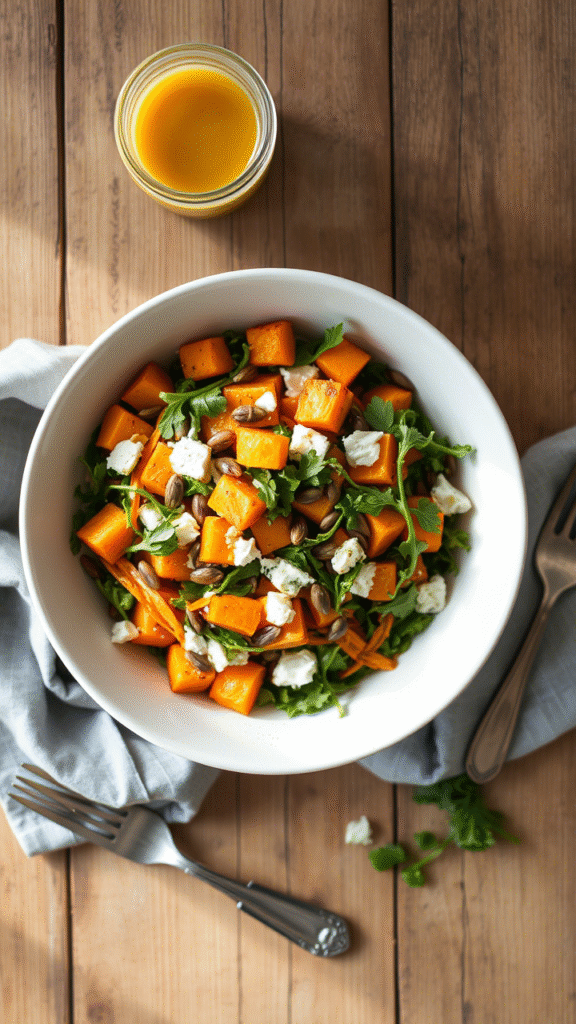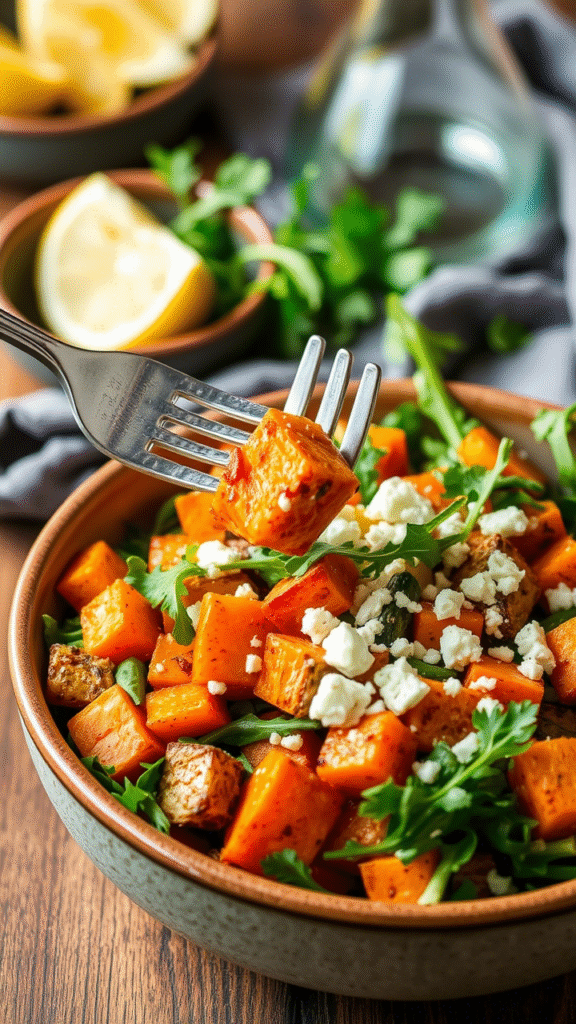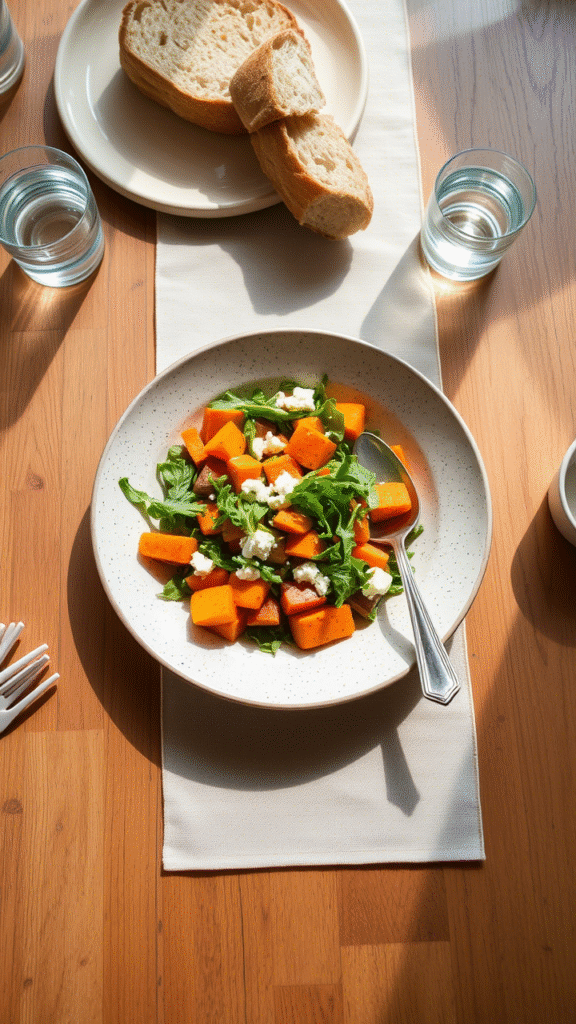Ever find yourself craving something vibrant and cozy at the same time? Like a dish that’s warm yet fresh, hearty but also light? That’s exactly what this Roasted Sweet Potato and Carrot Salad with Lemon Vinaigrette does — it’s that rare kind of recipe that hits a million notes perfectly. Imagine tender, caramelized sweet potatoes and carrots roasted to perfection, tossed in a bright, zesty lemon vinaigrette that cuts through the natural sweetness with a clean, crisp finish. It’s a salad, yes, but also a celebration of roots and tang, earth and sunshine.
What makes this recipe stand apart, though? It’s not just about throwing roasted veggies on greens. There’s an interplay of textures and flavors that professionals will appreciate — the slow roast that coax out the deep sugars in the veg, the acidity balancing act with the vinaigrette, and the subtle crunch from optional toasted nuts or seeds. And trust me, when you get that vinaigrette right, it’s like a light switch goes off in the mouth. This dish carries a subtle nod to Mediterranean and Middle Eastern influences where roasted roots and citrus are classic pairings, yet it’s versatile enough to reinvent in countless ways. Ready to deep dive into this beauty?
Ingredients & Substitutions: Choosing Your Palette Wisely

First off, the stars of the show: sweet potatoes and carrots. Go for fresh, firm sweet potatoes with smooth skin — avoid those with sprouts or bruises. Their starch content is just right for roasting, giving you that soft inside and caramelized outside. Carrots? The fresher and more vibrant, the better. If you can find heirloom or rainbow carrots, even better — they add not just color but subtle flavor complexity.
Here’s what you’ll need:
- 2 medium sweet potatoes, peeled and cubed (about 1-inch pieces)
- 3 large carrots, peeled and cut into similar sized chunks
- 3 tablespoons extra virgin olive oil
- Salt and freshly cracked black pepper, to taste
- 1 tablespoon fresh thyme leaves or 1 teaspoon dried thyme
- 1 tablespoon honey or maple syrup (optional, but enhances caramelization)
- 4 cups mixed greens or baby spinach (optional base)
For the lemon vinaigrette:
- 1/4 cup fresh lemon juice (about 2 lemons)
- 1/3 cup extra virgin olive oil
- 1 teaspoon Dijon mustard
- 1 teaspoon honey or agave nectar
- 1 small garlic clove, finely minced
- Salt and black pepper to taste
Substitutions and Tweaks
- Sweet Potatoes: If unavailable, try butternut squash or pumpkin. Both roast beautifully but note, butternut is softer and sweeter.
- Carrots: Parsnips or golden beets can replace carrots, offering earthier notes.
- Honey: For strict vegans, swap honey with maple syrup or agave nectar.
- Greens: For a grainier, more filling salad, add cooked quinoa or farro instead of greens.
- Herbs: Thyme is classic here, but rosemary or sage can offer a woodier aroma.
Fresh herbs are the real deal here. Dried herbs can work, but their flavor is less vibrant and can feel muted next to bright lemon juice. Fresh thyme leaves literally burst with aroma when roasted.
Step-by-Step Instructions: Roasting with Precision and Punch

- Prep and Preheat: Set your oven to 425°F (220°C). This high temp is essential for caramelization without drying the veg out. Toss sweet potatoes and carrots with olive oil, salt, pepper, thyme, and optional honey or maple syrup in a bowl. Spread them evenly on a baking sheet — don’t overcrowd, or they’ll steam instead of roast.
- Roasting: Slide the tray into the oven. Roast for 25-30 minutes, stirring once halfway through. You want golden, slightly crisp edges with tender insides. Watch the tray closely near the end — sugars can burn quickly. If you see too much browning but the veggies are still firm, lower the temp to 400°F and roast a bit longer.
- Vinaigrette Magic: While veg roast, whisk together lemon juice, olive oil, Dijon mustard, honey, minced garlic, salt, and pepper in a bowl or jar. Taste and adjust — more lemon if you want brightness, more honey if it’s too tart. The mustard emulsifies the vinaigrette, making it velvety and cohesive.
- Assembly: Once roasted, let veggies cool for 5 minutes — you don’t want them piping hot on delicate greens, or it’ll wilt them immediately. Toss roasted sweet potatoes and carrots with your greens (if using). Drizzle with lemon vinaigrette and toss gently but thoroughly.
Common Pitfalls & Tips
- Overcrowding: Crowding veggies on the pan leads to steaming, not roasting — no caramelization.
- Uneven cutting: Try to cut veg uniformly for even cooking. Mixed sizes means some bits burn while others remain hard.
- Too much acid: Lemon juice can overwhelm. Start small, taste, then add more.
Variations to Play With
- Spice lovers: toss in a pinch of smoked paprika or cayenne for smoky heat.
- Crunch factor: sprinkle toasted pumpkin seeds or chopped walnuts on top.
- Cheese fans: crumbled feta or goat cheese adds creaminess that contrasts beautifully.
Cooking Techniques & The Science Behind It
Roasting at high heat triggers the Maillard reaction and caramelization. The Maillard reaction is a chemical process where amino acids and sugars in the vegetables react under heat to form complex flavors and brown pigments. Caramelization, specifically, breaks down sugars to develop that sweet, nutty flavor with rich, golden hues.
This is why roasting rather than boiling or steaming is key — you get flavor depth, not just softened vegetables. The dry heat of roasting concentrates sugars and intensifies aroma.
The lemon vinaigrette uses emulsification — the mustard acts as an emulsifier, binding oil and lemon juice into a smooth dressing that clings to each roasted piece instead of sliding off. Garlic and lemon add pungency and acidity that brighten the roasted veg’s sweetness, balancing the dish.
Using a rimmed baking sheet is better than a flat pan here. It lets you toss the veggies easily without spills, and the rims help catch caramelized bits for scraping onto the salad later — those bits are flavor gold.
Serving & Pairing Suggestions: How to Plate This Beauty

Serve this salad slightly warm or at room temp for max flavor. Presentation-wise, mound the greens gently on a shallow plate or bowl. Arrange the roasted veggies artfully on top, showing off their golden edges and vibrant orange hues. Scatter fresh thyme leaves or microgreens for color contrast.
This salad pairs marvelously with grilled meats like chicken or lamb, or as a hearty vegetarian main when paired with warm pita bread or roasted chickpeas. A crisp white wine like Sauvignon Blanc or a dry rosé elevates the citrus notes in the vinaigrette.
For a full Mediterranean-inspired meal, serve alongside hummus, olives, and warm flatbreads.
Conclusion
This Roasted Sweet Potato and Carrot Salad with Lemon Vinaigrette isn’t just a salad. It’s a masterclass in balancing sweet and sour, soft and crisp, earthy and bright. The roasting technique unlocks hidden sugars and umami-like notes in humble roots, while the vinaigrette’s zingy punch keeps things lively and fresh.
It’s flexible, forgiving, and visually stunning. Plus, it invites endless customization — more spice, crunch, herbs, or protein — so it’s great for pros and home cooks alike. Next time you want a dish that says “comfort food but make it elegant,” reach for this one.
Oh, and if you want the ultimate tip? Roast your veggies ahead of time and let them marinate in the vinaigrette overnight. The flavors deepen like a good wine.
FAQs
Q1: Can I make this salad vegan?
Yes, simply use maple syrup or agave nectar instead of honey. The salad is naturally vegan-friendly and packed with plant-based goodness.
Q2: How do I store leftovers?
Keep the roasted veggies and vinaigrette separate in airtight containers for up to 3 days. Toss them together just before serving to maintain texture.
Q3: Can I use bottled lemon juice?
Fresh lemon juice is highly recommended for brightness and flavor complexity. Bottled lemon juice often tastes flat and lacks the zing needed here.
Q4: What if I don’t have Dijon mustard?
You can substitute with whole grain mustard or omit it, but mustard really helps with emulsification and flavor depth.
Q5: Can this salad be served cold?
Absolutely! It works well chilled, though warming it slightly releases more aroma and flavor.

Food lover, recipe creator & the heart behind NoshCrafters.com. Olivia shares mouthwatering, easy-to-make dishes that turn everyday meals into unforgettable bites. When she’s not experimenting in the kitchen, she’s busy plating up inspiration for home cooks everywhere.